
The marketing mix principles are used by business as tools to assist them in pursuing their objectives. The marketing mix principles are controllable variables, which have to be carefully managed and must meet the needs of the defined target group. The marketing mix is apart of the organisations planning process and consists of analysing the defined:
- How will you design, package and add value to the product. (Product Strategies)
- What pricing strategy is appropiate to use (Price Strategies)
- Where will the firm locate?(Place Strategies)
- How will the firm promote its product(Promotion Strategies)

A.Product Strategies
When an organisation introduces a product into a market they must ask themselves a number of questions.
- Who is the product aimed at?
- What benefit will they expect?
- How do they plan to position the product within the market?
- What differential advantage will the product offer over their competitors?
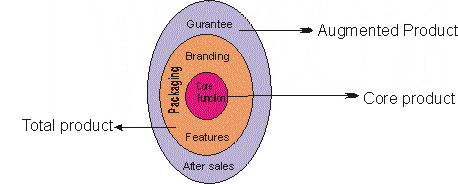
A product should be viewed in three levels.
Level 1: Core Product. What is the core benefit your product offers?. Customers who purchase a camera are buying more then just a camera they are purchasing memories.
Level 2 Actual Product: All cameras capture memories. The aim is to ensure that your potential customers purchase your one. The strategy at this level involves organisations branding, adding features and benefits to ensure that their product offers a differential advantage from their competitors.
Level 3: Augmented product: What additional non-tangible benefits can you offer? Competition at this level is based around after sales service, warranties, delivery and so on. John Lewis a retail departmental store offers free five year guarantee on purchases of their Television sets, this gives their `customers the additional benefit of ‘piece of mind’ over the five years should their purchase develop a fault.
Product Decisions
When placing a product within a market many factors and decisions have to be taken into consideration. These include:
Product design – Will the design be the selling point for the organisation as we have seen with the iMAC, the new VW Beetle or the Dyson vacuum cleaner.
Product quality: Quality has to consistent with other elements of the marketing mix. A premium based pricing strategy has to reflect the quality a product offers.
Product features: What features will you add that may increase the benefit offered to your target market? Will the organisation use a discriminatory pricing policy for offering these additional benefits?
Branding: One of the most important decisions a marketing manager can make is about branding. The value of brands in today’s environment is phenomenal. Brands have the power of instant sales, they convey a message of confidence, quality and reliability to their target market.
Brands have to be managed well, as some brands can be cash cows for organisations. In many organisations they are represented by brand managers, who have hugh resources to ensure their success within the market.
A brand is a tool which is used by an organisation to differentiate itself from competitors. Ask yourself what is the value of a pair of Nike trainers without the brand or the logo? How does your perception change?
Increasingly brand managers are becoming annoyed by ‘copycat’ strategies being employed by supermarket food retail stores particular within the UK . Coca-Cola threatened legal action against UK retailer Sainsbury after introducing their Classic Cola, which displayed similar designs and fonts on their cans.
Internet branding is now becoming an essential part of the branding strategy game. Generic names like Bank.com and Business.com have been sold for £m’s. ( Recently within the UK banking industry we have seen the introduction of Internet banks such as cahoot.com and marbles.com the task by brand managers is to make sure that consumers understand that these brands are banks!
B.Pricing Strategies
Pricing is one of the most important elements of the marketing mix, as it is the only mix, which generates a turnover for the organisation. The remaining 3p’s are the variable cost for the organisation. It costs to produce and design a product, it costs to distribute a product and costs to promote it. Price must support these elements of the mix. Pricing is difficult and must reflect supply and demand relationship. Pricing a product too high or too low could mean a loss of sales for the organisation. Pricing should take into account the following factors:
Fixed and variable costs.
Competition
Company objectives
Proposed positioning strategies.
Target group and willingness to pay.
Pricing Strategies
An organisation can adopt a number of pricing strategies. The pricing strategies are based much on what objectives the company has set itself to achieve.
Penetration pricing: Where the organisation sets a low price to increase sales and market share.
Skimming pricing: The organisation sets an initial high price and then slowly lowers the price to make the product available to a wider market. The objective is to skim profits of the market layer by layer.
Competition pricing: Setting a price in comparison with competitors.
Product Line Pricing: Pricing different products within the same product range at different price points. An example would be a video manufacturer offering different video recorders with different features at different prices. The greater the features and the benefit obtained the greater the consumer will pay. This form of price discrimination assists the company in maximising turnover and profits.
Bundle Pricing: The organisation bundles a group of products at a reduced price.
Psychological pricing: The seller here will consider the psychology of price and the positioning of price within the market place. The seller will therefore charge 99p instead £1 or $199 instead of $200
Premium pricing: The price set is high to reflect the exclusiveness of the product. An example of products using this strategy would be Harrods, first class airline services, porsche etc.
Optional pricing: The organisation sells optional extras along with the product to maximise its turnover. This strategy is used commonly within the car industry.
C.Place Strategies
Refers to how an organisation will distribute the product or service they are offering to the end user. The organisation must distribute the product to the user at the right place at the right time. Efficient and effective distribution is important if the organisation is to meet its overall marketing objectives. If organisation underestimate demand and customers cannot purchase products because of it profitability will be affected.
What channel of distribution will they use?
Two types of channel of distribution methods are available. Indirect distribution involves distributing your product by the use of an intermediary. Direct distribution involves distributing direct from a manufacturer to the consumer e.g. For example Dell Computers. Clearly direct distribution gives a manufacturer complete control over their product.
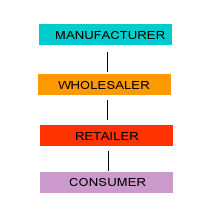
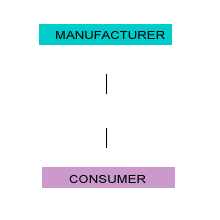
Distribution Strategies
Depending on the type of product being distributed there are three common distribution strategies available:
1. Intensive distribution: Used commonly to distribute low priced or impulse purchase products eg chocolates, soft drinks.
2. Exclusive distribution: Involves limiting distribution to a single outlet. The product is usually highly priced, and requires the intermediary to place much detail in its sell. An example of would be the sale of vehicles through exclusive dealers.
3. Selective Distribution: A small number of retail outlets are chosen to distribute the product. Selective distribution is common with products such as computers, televisions household appliances, where consumers are willing to shop around and where manufacturers want a large geographical spread.
If a manufacturer decides to adopt an exclusive or selective strategy they should select a intermediary which has experience of handling similar products, credible and is known by the target audience.
D.Promotion Strategies

Advertising: Is any non personal paid form of communication using any form of mass media.
Public relations: Involves developing positive relationships with the organisation media public. The art of good public relations is not only to obtain favorable publicity within the media, but it is also involves being able to handle successfully negative attention.
Sales promotion: Commonly used to obtain an increase in sales short term. Could involve using money off coupons or special offers.
Personal selling: Selling a product service one to one.
Direct Mail: Is the sending of publicity material to a named person within an organisation. There has been a massive growth in direct mail campaigns over the last 5 years. Spending on direct mail now amounts to £18 bn a year representing 11.8% of advertising expenditure ( Source: Royal Mail 2000). Organisations can pay thousands of pounds for databases, which contain names and addresses of potential customers.
Direct mail allows an organisation to use their resources more effectively by allowing them to send publicity material to a named person within their target segment. By personalising advertising, response rates increase thus increasing the chance of improving sales. Listed below are links to organisation who's business involves direct mail.
Message & Media StrategyAn effective communication campaign should comprise of a well thought out message strategy. What message are you trying to put accross to your target audience?. How will you deliver that message? Will it be through the appropiate use of branding? logos or slogan design?. The message should reinforce the benefit of the product and should also help the company in developing the positioning strategy of the product. Companies with effective message strategies include:
Nike: Just do it.
Toyota: The car in front is a Toyota.
Media strategy refers to how the organisation is going to deliver their message. What aspects of the promotional mix will the company use to deliver their message strategy. Where will they promote? Clearly the company must take into account the readership and general behaviour of their target audience before they select their media strategy. What newspapers do their target market read? What TV programmes do they watch? Effective targeting of their media campaign could save the company on valuable financial resources.
Push & Pull Strategies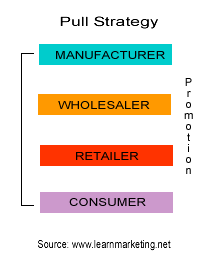
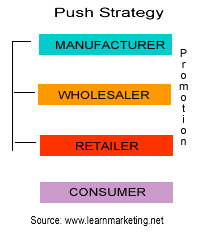
Above a pull strategy (up) push strategy (down).
Communication Model - AIDA

AIDA is a communication model which can be used by firms to aid them in selling their product or services. AIDA is an Acronym for Attention, Interest, Desire, Action.. When a product is launched the first goal is to grab attention. Think, how can an organisation use it skills to do this? Use well-known personalities to sell products? Once you grab attention how can you hold Interest, through promoting features, clearly stating the benefit the product has to offer? The third stage is desire, how can you make the product desirable to the consumer? By demonstrating it? The final stage is the purchase action, if the company has been successful with its strategy then the target customer should purchase the product.
Promotion through the Product lifecycle.
As products move through the four stages of the product lifecycle different promotional strategies should be employed at these stages to ensure the healthy success and life of the product .
Stages and promotion strategies employed.
Introduction
When a product is new the organisations objective will be to inform the target audience of its entry. Television, radio, magazine, coupons etc may be used to push the product through the introduction stage of the lifecycle. Push and Pull Strategies will be used at this crucial stage.
Growth
As the product becomes accepted by the target market the organisation at this stage of the lifecycle the organisation works on the strategy of further increasing brand awareness to encourage loyalty.
Maturity
At this stage with increased competition the organisation take persuasive tactics to encourage the consumers to purchase their product over their rivals. Any differential advantage will be clearly communicated to the target audience to inform of their benefit over their competitors.
Decline
As the product reaches the decline stage the organisation will use the strategy of reminding people of the product to slow the inevitable
Internet promotion
The development of the world wide web has changed the business environment forever. Dot com fever has taken the industry and stock markets by storm. The e-commerce revolution promises to deliver a more efficient way of conducting business. Shoppers can now purchase from the comfort of their home 24 hours a day 7 days a week. However, particularly in the UK the e-commerce revolution is hindered by two factors. Firstly the cost of logging on to the net. Consumers are still weary of the time-spent surfing, the high cost is slowing down the take-up. The number of homes that are linked to the web in the UK is only 25% of all house owner. If e-commerce businesses are to succeed the home penetration rate of internet access must also increase. Secondly, most homes are linked to modems of 56K. As the growth of people signing on-line grows the access speed slows down. In America most consumers only spend 10 seconds browsing on a web page, before they change sites, within the UK it is 2 minutes. The future seems to be with ADSL networks which will speed up access to the Internet dramatically running at 512K per second. However, again whether this format is adapted depends much on the cost.
Owning a website is a now a crucial ingredient to the marketing mix strategy of an organisation. Consumers can now obtain instant information on products or services to aid them in their crucial purchase decision. Sony Japan took pre-orders of their popular Playstaion 2 console over the net, which topped a 1 million after a few days, European football stars are now issuing press releases over the web with the sites registered under their own names. Hit rates are phenomenal.

Really i appreciate the effort you made to share the knowledge.The topic here i found was really effective
YanıtlaSilbusiness marketing company
This is really the reason why those companies are now turning towards direct mail marketing technique like snap pack yet in improvised fashion.
YanıtlaSilNice article on Marketing Mix.
YanıtlaSil